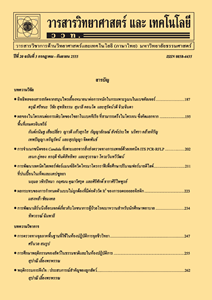ผลของความหนาแน่นกำลังดิสชาร์จและการอบต่อโครงสร้างผลึกของฟิล์มวานาเดียมออกไซด์ที่เตรียมโดยเทคนิครีแอคทีฟแมกนีตรอนสปัตเตอริง
Main Article Content
Abstract
บทคัดย่อ
ในงานวิจัยนี้ได้เตรียมฟิล์มวานาเดียมออกไซด์ที่สถานะสารประกอบโดยใช้แหล่งกำเนิดที่แตกต่างกันระหว่างดีซีแมกนีตรอนสปัตเตอริง (DCMS) และไฮล์พาวเวอร์อิมพัลส์แมกนีตรอนสปัตเตอริง (HiPIMS) ผลของความหนาแน่นกำลังดิสชาร์จได้ผ่านการตรวจสอบ โดยผลที่ได้แสดงให้เห็นว่าแหล่งกำเนิดแบบ HiPIMS จะให้พีคความหนาแน่นกำลังดิสชาร์จประมาณ 110 W/cm2 ในช่วงจ่ายพัลส์ 100 µs ในขณะที่แหล่งกำเนิดแบบ DCMS จะให้ค่าความหนาแน่นกำลังดิสชาร์จคงที่ประมาณ 20 W/cm2 โครงสร้างผลึกของฟิล์มวานาเดียมออกไซด์ถูกตรวจสอบโดยใช้เทคนิคการเลี้ยวเบนรังสีเอกซ์ (XRD) สำหรับเงื่อนไขที่แตกต่างกันของความหนาแน่นกำลังดิสชาร์จและกระบวนการอบ ฟิล์มวานาเดียมออกไซด์ที่เตรียมได้ด้วยแหล่งกำเนิดทั้งสองมีโครงสร้างเป็นอสัณฐานและมีพีค XRD ขนาดเล็กเกิดตรงบริเวณ 2q ที่แตกต่างกัน อย่างไรก็ตาม ฟิล์มวานาเดียมออกไซด์ที่มีโครงสร้างอสัณฐานนี้ภายหลังการอบฟิล์มในอากาศจะแสดงโครงสร้างผลึกเป็น V2O5 และความเป็นผลึกของฟิล์มจะขึ้นอยู่กับอุณหภูมิการอบ การจัดเรียงตัวระนาบของฟิล์ม V2O5 มีระนาบเด่นที่ระนาบ (001) และ (110) สำหรับแหล่งกำเนิดแบบ DCMS และ HiPIMS ตามลำดับ นอกจากนั้นแล้วโครงสร้างอสัณฐานของฟิล์มวานาเดียมออกไซด์ที่เตรียมด้วยแหล่งกำเนิดแบบ DCMS ถูกเปลี่ยนให้เป็นโครงสร้างผลึกของ V2O5 และ VO2 ภายหลังการอบในสุญญากาศ ผลที่ได้เหล่านี้ทำให้ทราบว่าเฟสโครงสร้างผลึกของฟิล์มวานาเดียมออกไซด์สามารถควบคุมได้โดยใช้ความหนาแน่นกำลังดิสชาร์จและกระบวนการอบฟิล์ม
คำสำคัญ : ความหนาแน่นกำลังดิสชาร์จ; การอบ; โครงสร้างผลึก; วานาเดียมออกไซด์; รีแอคทีฟแมกนีตรอนสปัตเตอริง
Abstract
In this work, the vanadium oxide films are prepared at compound mode by different power supplies between direct current magnetron sputtering (DCMS) and high power impulse magnetron sputtering (HiPIMS). Discharge power density of both power supplies are investigated. Experimental results showed that the HiPIMS supply generated peak of discharge power density about 110 W/cm2 with pulse on for 100 µs while DCMS supply generated smooth discharge power density about 20 W/cm2. The crystal structures of vanadium film are characterized by x-ray diffraction (XRD) technique for different conditions of discharge power density and annealing processes. As-deposited vanadium oxide films prepared by using both DCMS and HiPIMS supplies showed amorphous structure and small XRD peak at difference 2q. However, vanadium oxide films with amorphous structure after annealing in air indicated the V2O5 structure and the crystallinity of vanadium oxide films also depended on annealing temperature. The preferential orientation of V2O5 films are dominated at the plane (001) and (110) for power supplies of DCMS and HiPIMS, respectively. Moreover, amorphous structure of vanadium oxide films deposited by DCMS supply is changed to crystal structure of V2O5 and VO2 structure via annealing in vacuum. It was found that the crystal structure phase of vanadium oxide films could be controlled by both discharge power density and annealing processes.
Keywords: discharge power density; annealing; crystal structure; vanadium oxide; reactive magnetron sputtering


